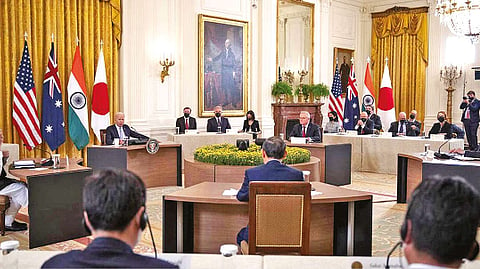

Chennai: When the Quad was first conceived as a strategic coalition of the Indo-Pacific’s four leading democracies, many doubted that it would amount to much. Chinese Foreign Minister Wang Yi mocked it as a “headline-grabbing idea” that would dissipate “like the sea foam in the Pacific or Indian Ocean.” But continued Chinese expansionism, combined with former Japanese Prime Minister Abe Shinzo’s determination to build broad resistance to it, has produced an increasingly consolidated group, with real potential to bolster regional security. The question is whether it will deliver.
One thing is certain: all four Quad members – Australia, India, Japan, and the United States – are essential to realise the vision of a “free and open Indo-Pacific” introduced by Japan in 2016 and affirmed by the US in 2017. While the Quad took some time to get off the ground – it was resurrected during US President Donald Trump’s administration but leaders’ summits began only after Joe Biden took office – it has gained considerable momentum. Its members have held three summits since last year (two of them virtual) and are set to meet in person in Tokyo on May 24.
But the Quad still has a long way to go, not least because its members’ own actions are undercutting its strategic rationale – the need to prevent China from upending security in the Indo-Pacific. A key problem is that all four countries have allowed themselves to be seduced by the Chinese narrative that economic relations can be separated from geopolitics.
China’s trade surplus, which reached a record $676.4 billion last year, is now the main engine of its economy. Without it, Chinese growth would likely stall, especially as President Xi Jinping strengthens state control over private companies. This would also hinder China’s ability to invest in its military and finance its aggressive manoeuvres in the Indo-Pacific and beyond.
And yet the US and India are major contributors to China’s trade surplus. The US leads the way: its trade deficit with China swelled by more than 25% in 2021, to $396.6 billion, and now comprises over 58% of China’s total surplus. India’s trade deficit with China – which hit $77 billion in the 12 months through this March – exceeds its defense budget, even as the two countries are locked in a dangerous military confrontation on their long Himalayan frontier.
China’s stealth encroachments on some Indian border areas in 2020 triggered deadly clashes, setting in motion a build-up of forces and border infrastructure that continues to this day. This should have been a wake-up call for Indian Prime Minister Narendra Modi, who had been so committed to appeasing China that he was blindsided by its aggression. But India’s large and growing trade deficit with China suggests that he is still asleep.
Australia and Japan have similarly built up significant dependency on Chinese trade. China accounts for nearly one-third of Australia’s international trade and is Japan’s largest export market. Moreover, both countries are members of the China-led Regional Comprehensive Economic Partnership. For them, enabling China to shape trade rules in the Indo-Pacific is apparently a small price to pay for the economic benefits of increased regional commerce.
Rather than continuing to underwrite China’s economic and geopolitical power, the Quad should be making economic cooperation – including increased trade among its members – a central feature of its agenda. Unfortunately, though Biden has pledged to unveil an Indo-Pacific Economic Framework covering everything from infrastructure to the digital economy, his administration’s unwillingness to commit more resources to the region or offer regional partners better access to US markets severely limits the initiative’s potential. Moreover, Biden has pushed an expansive Quad agenda covering topics that have nothing to do with the group’s core objectives – everything from climate change to COVID-19 vaccine delivery to supply-chain resilience.
America’s deepening proxy conflict with Russia further muddies the strategic picture. Biden is the third successive US president to commit to shifting America’s primary strategic focus to Asia and the wider Indo-Pacific. But the Ukraine war – which he believes “could continue for a long time” – may well cause him, like his predecessors, not to complete that pivot.
The war might also spur Biden to take a more conciliatory approach to China. Even before Russia invaded Ukraine, Biden had begun to ease pressure on China. He effectively let China off the hook for both obscuring COVID-19’s origins and failing to meet its commitments under the 2020 “phase one” trade deal with the US. He also dropped fraud charges against the daughter of the founder of the military-linked Chinese tech giant Huawei. US sanctions over China’s Muslim gulag remain essentially symbolic.
Now, as Biden attempts to ensure that Xi does not offer Russian President Vladimir Putin an economic lifeline, thereby neutralising the impact of Western sanctions, he is likely to adopt an even more conciliatory approach. Already, the US Trade Representative has reinstated exemptions from Trump-era tariffs on 352 products imported from China. And now the White House is considering a broader reduction of tariffs on non-strategic goods from China.
The Quad can hold as many leaders’ summits as it wants, but without a clear strategic vision – and an agenda to match – it will have little impact. The group’s purpose is to act as a bulwark against Chinese expansionism and ensure a stable balance of power in the Indo-Pacific. At its May 24 summit, all other issues should take a backseat to this objective.
Brahma Chellaney, Professor of Strategic Studies at the New Delhi-based Center for Policy Research is Fellow at the Robert Bosch Academy in Berlin
Visit news.dtnext.in to explore our interactive epaper!
Download the DT Next app for more exciting features!
Click here for iOS
Click here for Android